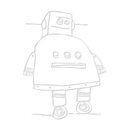Introduction: T Vault - a Parametric Belt Clip for Your Favorite Tea!
For me, there is nothing better than a hot cup of tea on a cold winter day! However, sometimes I don't have time for tea before I am off to college, and I prefer to make it on campus rather than bring it with me in a tumbler.
Introducing the T-Vault! A custom belt clip that let you carry around your favorite kind of tea without any compromise for its safety!
The T-Vault is based on a fully parametric model - which means that even if you are new to CAD or 3D printing, you can easily customize it to fit your belt and tea brand.
Supplies
Tools:
- 3D printer and some filament - I used standard PLA filament
- Soldering iron -
- Metric Allen wrenches
- Hacksaw/Angle Grinder or any other tool to cut the steel rods
OTS (off-the-shelf) Parts:
- (1) D3mm L130mm Steel Rods - Length my vary depending on your customized design
- (4) DIN 7991 M3x10 (Hexagon socket countersunk head screws)
- (4) DIN 982 M3 (Nylon insert lock nuts)
- (4) DIN 912 M2x10 (Hexagon socket screws)
- (4) M2 Heat set thread insert
- (2) Rubber bands - mine had an ID of around 37mm
Optional:
- Soldering iron tips for heat set inserts - I don't have these, so I just use a standard conical tip
Step 1: Customize the Design
I designed the T-Vault using Fusion 360 - Why?
- Free for hobbyists
- Easy to use without extensive CAD experience
- There's a built-in McMaster-Carr interface which makes working with COTS hardware so simple
- There are tons of plugins and add-ons available
Customizing the design is easy! Just follow the following steps:
- Open the F3D file in Fusion360.
- Click on 'Modify' -> 'Change Parameters'
- Make sure you see the 'Favorite Parameters' section
- Adjust the 4 parameters:
- 'Belt_Width' - Measure the width of your belt and insert here
- 'Belt_Thickness' - Measure the thickness of your belt and insert here
- 'Tea_Envelope_Width' - Measure the width of the tea envelope (usually the short side)
- 'Tea_Envelope_Length' - Measure the length of the tea envelope (usually the long side)
- Now just click 'OK' and the design will adjust itself!
I used a simple steel ruler to measure the tea envelope and a caliper for the belt
Step 2: Print the Parts
After customizing the design you can now export STL files for 3D Printing.
- Click on 'File' -> '3D Print'
- Choose one part
- Make sure 'Unit Type' is set to Milimeters and 'Refinment' is set to High
- Click 'OK' and choose a file name and location
- Repeat for all other parts
In total, you should have 4 STL files:
- Belt Clip
- Bottom Jaw
- Top Jaw
- Rubber Band Hook
I printed all parts using my default setting:
- 3 walls/perimeters
- 20% infill
- Brim
- No supports
- You can see the suggested print orientation in the attached image
Step 3: Cut the Steel Rod
- After customizing the design, measure the linear rods' length in the model
- Cut the steel rod to length (x2)
- You might need to use a file or a sandpaper to remove burrs at the cutting point
Step 4: Install Heat Set Threaded Inserts
Using a soldering iron, install (4) M2 heat set threaded inserts:
- 2 inserts installed on the Bottom Jaw
- 2 inserts installed on the Top Jaw
- Place the insert above the holes and gently press them in until the smooth part enters the hole
- Make sure the insert is perpendicular to the surface, otherwise it will be difficult to fix it later on
- Let the soldering iron heat up, if you have an adjustable temperature soldering iron, I suggest ~230deg c.
- Hold the soldering iron above the insert, try to align the tip with the internal thread
- Slowly press the insert using the soldering iron until it is flush with the printed part's surface
- Inspect the insert and make sure there is no molten plastic inside the thread
- Repeat 4 times
When installing the inserts, try to be as perpendicular as possible
If you have designated tips for threaded inserts - use them! Otherwise, use a standard conical tip and make sure you clean it from any plastic residue after you are done.
Step 5: Assemble!
Follow the instructions on the images above and assemble the T-Vault. The only tools youll need are 1.5mm and 2mm Allen wrenches to tighten the bolts.
- Attach the Belt clip to the Static Jaw using (4) M3 screws and (4) M3 nuts, the nuts should be gently pressed into the hexagonal recesses
- Insert the steel rods to the Static Jaw holes
- Depending on your 3D printer's tolerances, you might feel like the steel rods are not secured to the Bottom Jaw, in this case just use a couple of drops of super glue, just make sure to use gloves!
- Slide the Top Jaw on the steel rods until it aligns with the Bottom Jaw
- Using (4) M2 screws, attach (2) Rubber Band Hooks to the Top Jaw and (2) Rubber Band Hooks to the Bottom Jaw
- Strech (2) rubber bands and place them on the hooks vertically
- Assembly is done! Clip the T-Vault on your belt, insert your favorite tea, and have an awesome day!
Step 6: What's Next?
Some of the upgrades I was thinking about:
- 'Magazine' for multiple tea envelops
- Adjustable design to fit a variety of sizes
- Espresso capsule vault







